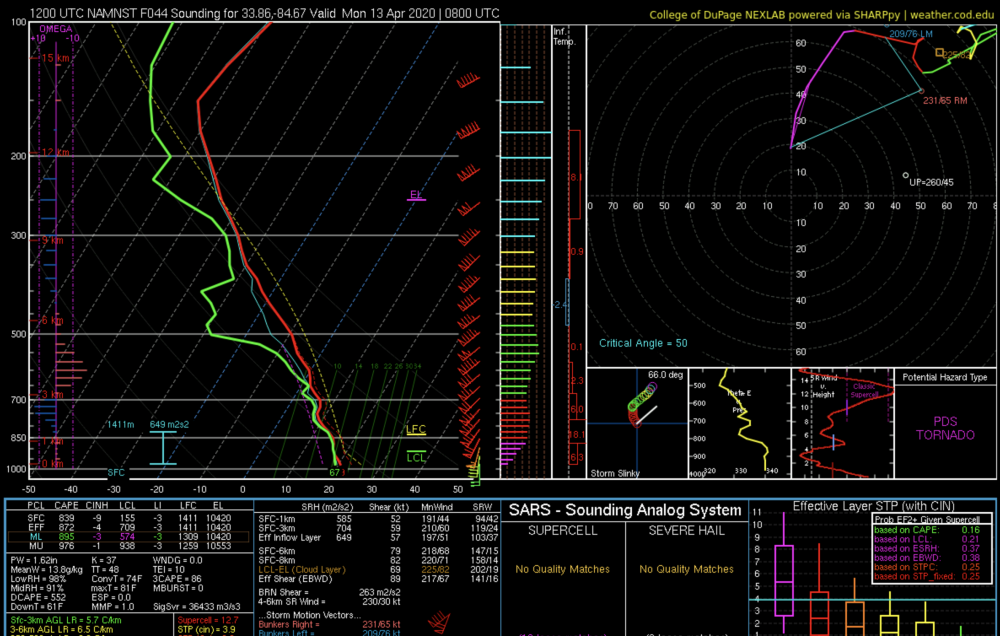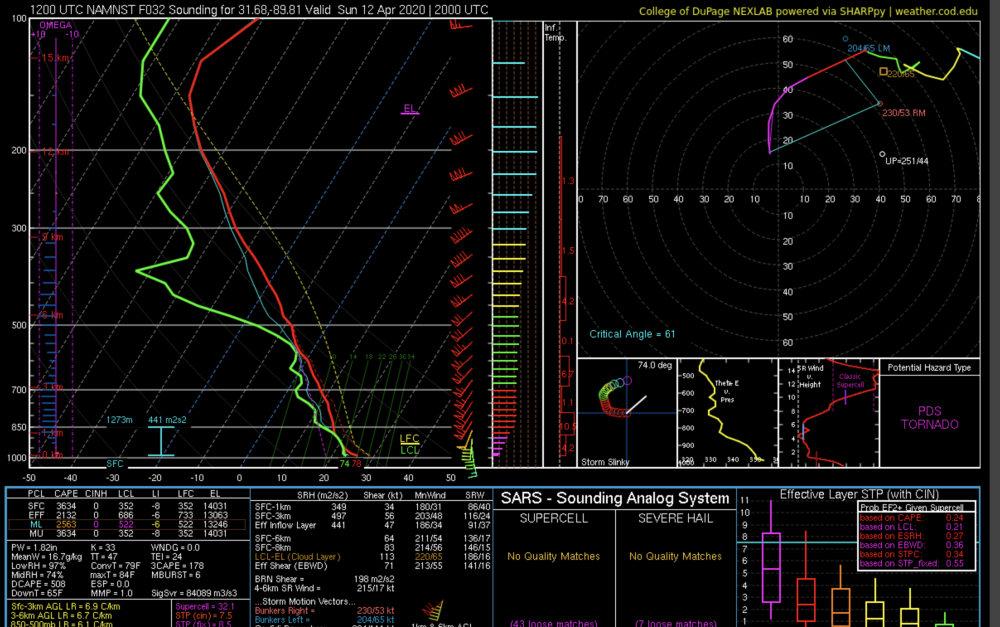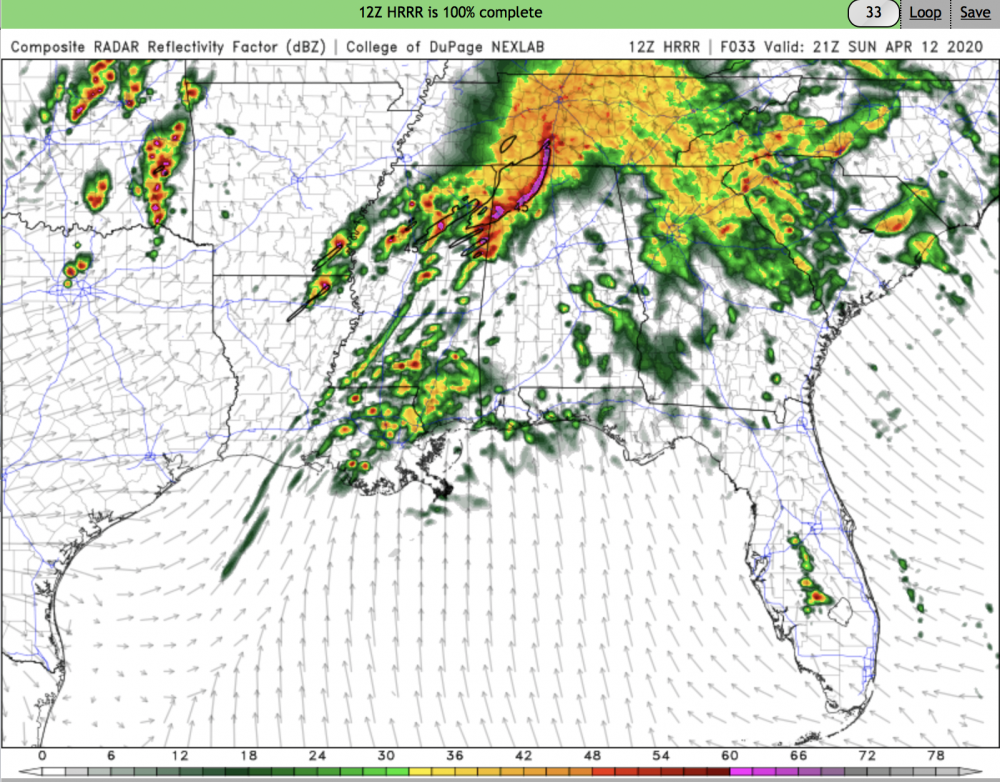
jpeters3
Meteorologist-
Posts
736 -
Joined
-
Last visited
Content Type
Profiles
Blogs
Forums
American Weather
Media Demo
Store
Gallery
Everything posted by jpeters3
-
You don't have to patronize with statements like this. Obviously UH tracks are not a direct indicator of a tornado. UH tracks in an environment that can support tornadoes suggest the possibility. Take a look at the models before posting. Below is a forecast sounding just west of ATL just before the UH track was produced. A low-shear very high CAPE type of scenario, but could certainly support a strong QLCS and/or embedded supercell related tornado threat.
-
The 12 UTC 3km NAM sends an UH track right over downtown ATL...
-
Good call on the Mod risk, IMO.
-
I would be cautious in interpreting these soundings from tropical tidbits. Strictly speaking, one should compare the virtual temperature of a lifted parcel to the virtual temperature of the background environment to assess lifted parcel buoyancy and CAPE, but their soundings use actual temperature. So this plot is misleading - the dashed line is probably a bit more to the right than indicated on here. Note that there is no MLCIN. This is actually a pretty good looking thermodynamic profile. Attached is a similar sounding from the same approximate location and time, plotted correctly from dupage. You can see that there is actually quite a bit of low-level buoyancy for a lifted parcel.
-
This seems like the responsible decision given the lingering uncertainty.
-
Depending on where you pick a sounding overnight in AL, the environment is going to be on the borderline of being supportive for violent tornadoes. There is the issue of lacking buoyancy below 3 km, but relatively off-the-chart wind profiles. It's also a bit hard to interpret whether the 3 km NAM is depicting supercells, or junkvection with embedded spin-ups. But I agree, AL is certainly in play in the late evening/overnight, along with central TN.
-
I don't think you are a nutjob at all. This is quite possibly an explanation for the different solutions.
-
Another CAM solution to add to the mix. HRRR seems to air more toward the "outbreak" end of the spectrum by 2100 UTC, with numerous apparently discrete supercells developing over northern LA, MS, and SE AR in the high-parameter part of the warm sector. Edit: The end of the run is still sort of a mixed bag. Somewhere between the higher end and lower end solutions. Probably a regional outbreak with a few strong tornadoes.
-
Yeah. A tornado outbreak on top of a pandemic starts to sound like a SCI-FI channel mini-series plotline...
-
This is a tough call, but avoiding large groups in shelters which will almost certainly lead to additional covid infections in favor of a probably comparatively statistically unlikely outcome of a tornado hitting a given location seems like a good tradeoff to me.
-
Pretty much all the available sites do not plot maps of STP correctly. Most show fixed layer STP, when they should really show effective layer STP. I've also noticed large discrepancies between what is shown in SHARPpy soundings and what is shown on the map. I trust the soundings more-so than the maps, and maximum values i've seen are in the 6-9 range.
-
I think the point is that the chances of a repeat of April 27, 2011 are very small. Events like this are more than just parameters. There are a lot of things that need to come together to cause an outbreak like April 27. Miss one piece of the puzzle, and you can end up with a marginal event at best despite off-the-charts parameters (5-20 is a classic example of this, but there have been several over the past few years). And there are already indications that some of those things won't come together this time (questions about storm mode, etc). So if we "sound the alarm" and tell people this will be comparable to April 27, 2011, when in reality the probability of this happening is extremely low, we lose credibility as forecasters. I would put the chances of something comparable to that day at 5%, at best. Especially given that parameters look to be a tad smaller than 4-27 among the consensus of guidance on top of all the uncertainties.
-
Good assessment of the different runs here. It's pretty frustrating to have such a mixed-bag of solutions at this point, especially when the global models are in good agreement! Another interesting thing to note: the modeled depictions of the warm sector parameters are quite different among these runs. This is probably at least partially due to the different solutions for the distribution of convection through the warm sector, but I suspect something else is going on as well. The runs that are more geared toward a tornado outbreak actually have considerably less coverage of high 0-1 km SRH in the warm sector, even prior to widespread convective converge. Not sure why this is, or if it is even that important, but it is an interesting (and somewhat inexplicable difference).
-
Showing quite a bit of UH swaths over northern AL and into TN Sunday night though... Even if the daytime warm sector doesn't go of (and i'm not sold on that solution yet), it seems like there will be a substantial overnight event further east and north
-
NAM nest remains stubbornly devoid of convection through much of the warm sector. However, there do appear more discrete cells close to the triple point than in previous runs.
-
NAMcandy inbound
-
FWIW, 18 UTC NAM nest is a similar story. Warm sector is devoid of convection closer to the cold front, and a bunch of junkvection further east.... Interested to see what CAMs do tomorrow.
-
I would say the models have been trending toward a higher-end event over the last few days, in term of ingredients. The lapse rate issue was somewhat apparent in every model solution I've seen (though it seems ever so slightly less pronounced today). The NAM nest was a hiccup, but too early to throw in the towel. 18 UTC NAM coming in. Should we spar on this one????
-
Thanks. I never noticed it there.
-
Where do you look at 0-3km MLCAPE? There is a lot of recent research that supports the role of buoyancy in this layer in making/breaking tornado formation.
-
I just re-read your original post, and I realize that it was complementary and I mistook it as criticism. My apologies. I will delete my offending posts. I am cranky today, sorry.
-
While I don't think it is wrong to doubt this solution (I have my doubts too), I don't think it is good practice to forecast based on dogma and scientifically unfounded principles.
-
You are right about this one, but that is not what is happening here. The first CAM we get gives us a solution that would certainly qualify as a "bust." I don't think this is reason to reduce day 3 to a "see text", but it would be asinine to simply discount this solution based on ill-founded scientific reasoning.
-
The opposite of what?





